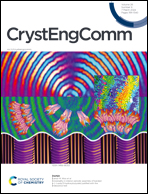A (4,6)-c copper–organic framework constructed from triazole-inserted dicarboxylate linker with CO2 selective adsorption†
Abstract
Angular ligands are a class of important linkers to design and construct new metal–organic frameworks (MOFs). Herein, solvothermal reaction of 4,4′-(4H-1,2,4-triazole-3,5-diyl)dibenzoic acid (TZDB), a triazole-inserted dicarboxylate, acetate, and Cu(NO3)2·3H2O afforded a copper(II)-organic framework of Cu-TZDB. Structural analysis shows that Cu-TZDB displays an unusual (4,6)-c topological network concomitant with the generation of metalloligand [Cu(TZDB)(H2O)2] in situ. Due to its bi-channel cavities replete with triazolate, coordinated water and methyl groups, Cu-TZDB exhibits CO2 selective adsorption over N2 and CH4, which was not only predicted by ideal adsorption solution theory (IAST), but also verified by dynamic column breakthrough tests.



 Please wait while we load your content...
Please wait while we load your content...